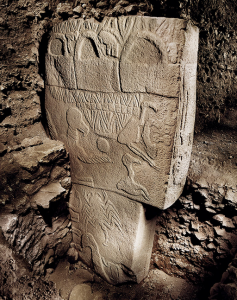They were there at the beginning, their furry tails and paws, their feathers and beaks carved with great detail on the huge stone pillars set in massive circles. The site is Göbekli Tepe (“tep-pay”) in southeastern Turkey, just north of the Syrian border.
Animals carved on pillars wouldn’t be so extraordinary except for this: the site is old—unbelievably old. It was built some 11,000 years ago, before agriculture, before human settlement, before even the making of pottery in the region. In other words, by hunter-gatherers.
I came upon the Wikipedia article a few weeks ago while following a rabbit trail for something else. I was astonished—the archeological site that is revolutionizing our view of human cultural development, and I’d never even heard of it.
Prior to the discovery of this site—and it’s been around for a while, excavated since 1994—the theory was that domesticating plants and animals—in a word, agriculture—had led to the formation of settlements, and once settled, humans had the leisure and the organizational power to begin developing architecture. Göbekli Tepe is completely upending that theory. There is no evidence for

Pillar with carved animals. Photo by Berthold Steinhilbert. Viewed originally at Smithsonian Magazine.
human settlement in the area prior to this building, and evidence for domestication of plants comes 500 to 1000 years after the building of these massive structures.
And the structures are indeed massive: T-shaped pillars set in circles thirty to ninety feet in diameter. Pillars that weigh seven tons, some of them thirty feet tall. Pillars that were carved and set in place 6,000 years before Stonehenge.
What could the structures possibly be? To everyone’s best guess, they are temples—places of worship. Before pottery, before farming, there was spirituality.
And what moves me most about these temples are the carvings of animals—foxes and scorpions, gazelle, vultures, and snakes covering many of the pillars. Animals were there at the beginning of human wonder, reverence, and awe.
For more information:
- “Gobekli Tepe: The World’s First Temple?” Smithsonian, Nov. 2008.
- “The World’s First Temple,” Archaeology, Nov./Dec. 2008.
- “Gobekli Tepe: History Being Uncovered,” YouTube 7 minute video. Excerpts from a BBC series begin about 2 minutes in.
- “Gobekli Tepe: Paradise Regained?” by Sean Thomas, 2008.
